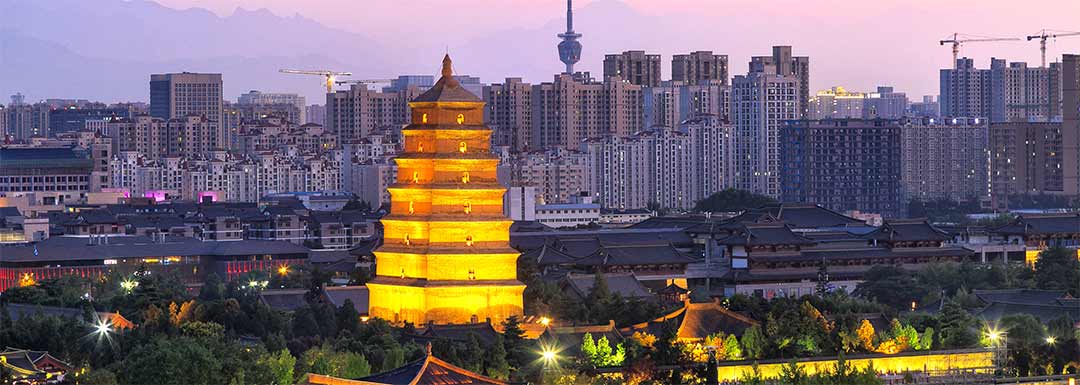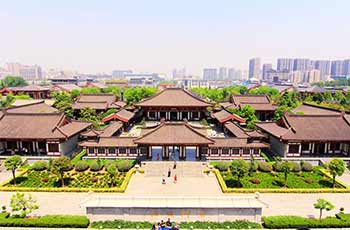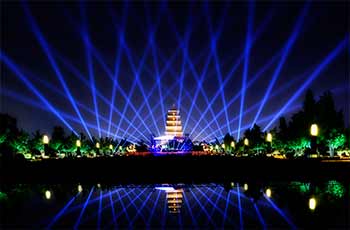The Big Wild Goose Pagoda

The Big Wild Goose Pagoda is located in the Da Ci'en Temple, the most magnificent imperial monastery in Chang'an from the time of the reign of Emperor Taizong in the Tang Dynasty, and built by Prince Li Zhi in honor of his mother Queen Wende. The first abbot of the Pagoda was Master Xuan Zang, who returned from a pilgrimage for Buddhist scriptures in India. Master Xuan Zang supervised the construction of the Big Wild Goose Pagoda during his tenure. The Pagoda was built to keep Sanskrit on the leaves of Pattra brought back from India and tens of thousands of pieces of Buddha's relics are buried here.
- Chinese name: 大雁塔 Dà Yàn Tǎ
- Duration: One-hour
- Entrance fee: RMB50. Another RMB30 to visit the Big Wild Goose Pagoda
- Opening hours: 09:00~17:00
- Best time to visit: March, April, May, September and October
- How to get there: Bus Y6, 21, 22, 24, 601 and 610, or Minibus 501 and 503.
Attractions in The Big Wild Goose Pagoda
1.Da Ci’en Temple
 Da Ci’en Temple
Da Ci’en Temple As the most famous and magnificent monastery of the Tang Dynasty in Chang’an, Da Ci’en was once kept by Xuan Zang, and therefore played a prominent role in China’s Buddhism history. The Great Buddha's Hall is the main building of the Pagoda and consecrated clay figures of the Three-body Buddha, Bodhisattva and Arhat, serving as a venue to chant sutras. The scale of today’s Ci’en Temple is largely based on that from the Ming Dynasty while most of the halls within were built during the Qing Dynasty.
The area to the east of the central axis is a garden with nine dagobas (shrines for sacred relics), consecrating the relics of the nine Buddhas of this temple since the Qing Dynasty.
2.Music Fountain of The Big Wild Goose Pagoda
The Music Fountain of the Big Wild Goose Pagoda in Xi’an is 480 m wide and 350 m long, covering an area of 252 mu (about 41 acres).
1) Opening time of the music fountain
 Music Fountain of The Big Wild Goose Pagoda
Music Fountain of The Big Wild Goose Pagoda June 10 – October 5:
A: Two sessions every day except Tuesday from Monday to Friday: one at 12:00 and the other at 21:00
B: Routine inspections on Tuesdays, with evening session only.
C: Five sessions on Saturdays & Sundays and in the holidays at 12:00, 14:00, 16:00, 18:00 and 21:00.
October 6 – October 31
A: Two sessions every day except Tuesday from Monday to Friday: one at 12:00 and the other at 20:30
B: Routine inspections on Tuesdays, with evening session at 20:39 only.
C: Five sessions on Saturdays & Sundays and in the holidays at 12:00, 14:00, 16:00, 18:00 and 20:30.
No performance sessions from November to January, with the Spring Festival as an exception.
2) Duration of the music fountain
Twenty to thirty minutes per session. Arrival in advance is suggested to avoid missing the performance.
3) Is a ticket needed for the music fountain?
No ticket needed. There are more visitors for the evening session, especially in summer. Best viewing sites are limited. Watch out for crowds and take care of your belongings.
Drop us a line and we'll connect you with the top China expert in no time!